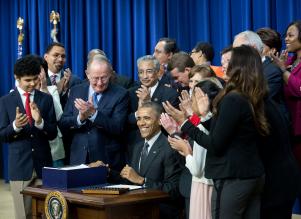2/26/2017
Quick Guide to the New Federal Education Policy
In December 2015, President Barack Obama signed the Every Student Succeeds Act (ESSA) into law, ushering in a long-awaited update to the 2001 No Child Left Behind Act.
The latter policy—frequently referred to as NCLB—carried with it an emphasis on accountability by mandating the annual testing of students in grades 3–8, and again in high school. So, how is ESSA different, exactly? Here is a shortlist of helpful things to know about the new law and how it may impact public education in the United States:
1. Testing requirements stay, but…
Under the ESSA, the requirement to test students every year in grades 3–8 and once in high school will remain. The content of these tests will still be dominated by standardized math, reading, and science assessments, but a new mandate requires states to publicly inform parents and community members about the tests—specifically which tests will be given, how much time schools spend on testing, and what rights parents have in regard to opting their children out of federally required tests.
Additionally, states now have the option of giving several shorter tests over the course of the school year, rather than a big “one-and-done” test in the spring.
2. More accountability, less pressure
Another holdover from the NCLB era will continue under ESSA: the disaggregation of student test score data. This means various “subgroups” (such as students in poverty and non-white students from a range of ethnic and racial backgrounds) will have their results reported separately so each group’s progress can be tracked.
Three new subgroups have been added under ESSA, which will put additional pressure on states to monitor and report on how homeless students, students in foster care, and children whose parents are in the military are doing. However, states will no longer be held to the never-realized 100-percent proficiency requirement that came with NCLB and dictated that all students should be proficient in reading and math by 2014. Rather than drawing a finish line in the sand, the ESSA law offers more of a “continuous progress” model.
3. English Language Learners get a boost
ESSA casts a larger spotlight on the progress and success of students who come to school proficient in a language other than English. English Language Learners, or ELLs, now make up close to 10 percent of all public-school students in the U.S.; under ESSA, more accommodations can be made for the unique needs of these students.
The annual testing requirement will still apply, but on a variable timetable: For example, students who are new to the country will be allowed to wait a year before taking the standardized Language Arts test, which supporters say will be an important step toward accommodating them. Also, for the first time, schools will have to show how quickly students are moving out of English learner classrooms and into mainstream education programs.
4. A boost for school libraries, too
The ESSA legislation has provided an unexpected bonus to the nation’s school libraries through greater funding options and a formal acknowledgement of their benefit. Under ESSA, states will be able to use federal money to support the instructional role librarians can play in often-overlooked areas such as media literacy or tech support.
Also, the law explicitly names school libraries and librarians, identifying both as integral parts of a school community—which marks a sea change, according to Jessica McGilvray writing for the American Library Association. McGilvray explained that school libraries were never mentioned in NCLB, and were thus made invisible: “We learned the hard way that if school libraries were not expressly written in, they were much too easily left out.” In contrast, ESSA not only directly refers to school libraries but includes many different ways libraries can benefit students and help provide a well-rounded learning environment.
There is much more to the ESSA law, which runs over 1,000 pages in length. What may be most appealing about it is the opportunity it offers states and community groups to rewrite what it means to hold schools accountable, and to help all students move forward.


